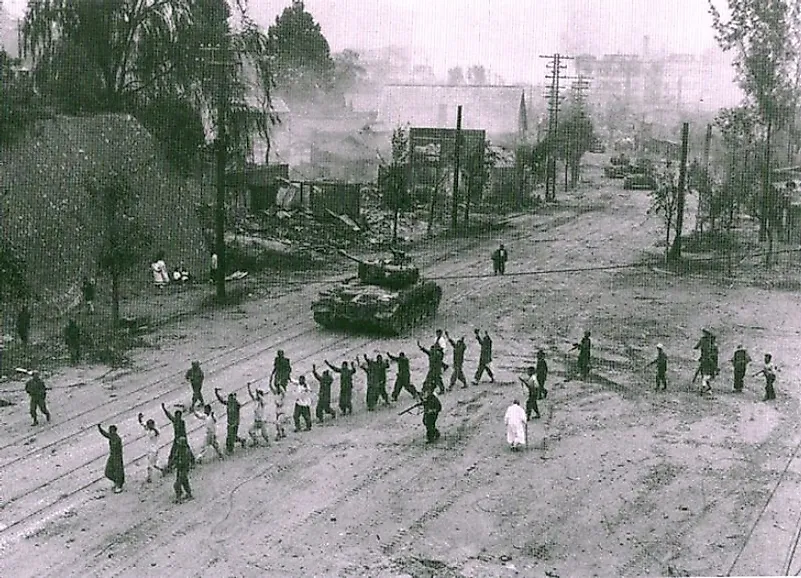Second Battle Of Seoul - Korean War

5. Background
The North Korean Army's offensive was broken at Pusan at the end of the Summer of 1950, culminating in the Great Naktong Offensive, one of the fiercest engagements of the Korean War. Though the North Koreans tried their best and almost overran the United Nations' (UN) troops, they failed in taking over the region. Overextended, under-supplied, and their momentum now broken, the North Korean People’s Army was finally vulnerable to United Nations member armies’ counterattacks. Particularly, U.S. General MacArthur envisioned a landing at Inchon to take back Seoul. Plans were drawn, and the X-Corps was activated and given command of the landing forces. The landings succeeded, and was a great tactical and strategic victory for the United Nations. Now, the UN army was ready to march onward to reclaim Seoul.
4. Makeup
The United States' side was made of the X Corps that landed at Inchon led by General Edward Almond. The X Corps is mostly composed of the 1st Marine Division led by Major General Oliver Prince Smith and the 7th Infantry Division led by Major General David G. Barr. These along with other US army troops brings us a troop count of 40,000 men. The U.S. forces were assisted in the fight by support from their United Nations allies South Korea, Canada, and the United Kingdom. On the North Korean side were two first-class units: the 2,500-man strong 25th Infantry Brigade on one hand, and the rest being comprised by the 78th Independent Infantry Regiment. All told, the North Korean People's Army had 7,000 available ground troops, along with a Soviet-designed T-34 tank column, and aerial bombing support from Yak aircrafts (also Soviet-designed) in the region.
3. Description
The US advance from Inchon was a slow and tedious affair, as the North Korean People’s Army successfully bogged down the allied advance. Fierce defense by the 78th and 25th Infantry allowed time for the North Korean People’s Army to withdraw troops from the south and fortify Seoul. A T-34 tank assault was launched by the North Korean People’s Army, but was successfully cut off and destroyed by U.S. forces. Similarly, Yak bombing runs were attempted with little success.
On September 22nd, 7 days after the landings at Inchon, the Marines finally entered Seoul. It was heavily fortified. Major General Edward Almond wanted the city retaken by September 25th, exactly 3 months since the North Korean offensive. Drawing parallels to the Battle of Manila in World War II, the Marines met heavy resistance and were forced to take the city house-by-house, block-by-block. As they ground away at the defenders, casualties mounted on both sides.
2. Outcome
Despite ongoing resistance on the northern parts, the city was declared liberated on September 25th, 3 days after the fight broke out. The US forces successfully took over the city. MacArthur's strategy was a decisive success. All told, the X Corps suffered more than 280 killed, and more than 720 wounded in the course of taking over the city. North Korean casualties were much larger, with 13,666 casualties incurred and 4,792 prisoners taken over the entire course of the Inchon-Seoul campaign.
Following the battle, South Korean police summarily executed some 600+ civilians and their families for being communist sympathizers in two large events. Some of the victims were teenagers and children with no connection to North Korea. These massacres came to be known as the Goyang Geumjeong Cave Massacre and the Namyangju Massacre.
1. Significance
This battle, along with the Inchon landings, played a significant role in the fight to repel the Communists back north. Before the campaign, South Korea was relegated to the Pusan perimeter. Though they successfully repelled the Naktong Offensive, the war was at a stalemate, with 8th US Army along with the South Korean Army unable to break the deadlock. The landing at Inchon and the successful capture of Seoul allowed the 8th Army and X Corps to perform a pincer attack on the North Korean troops in South Korea, finally driving them back north of the 38th Parallel. It was a massive strategic and tactical victory for the U.S. and its allies. It did, however, have the unfortunate effect of drawing increased Chinese presence into the war, the scope of which the UN allies likely never could have foreseen. In the next major battle around the South Korean capital city, the Chinese presence would facilitate a very different result. Private First Class Eugene A. Obregon was killed in the battle protecting a fellow U.S. Marine. Obregon received a posthumous Medal of Honor for his valor.











